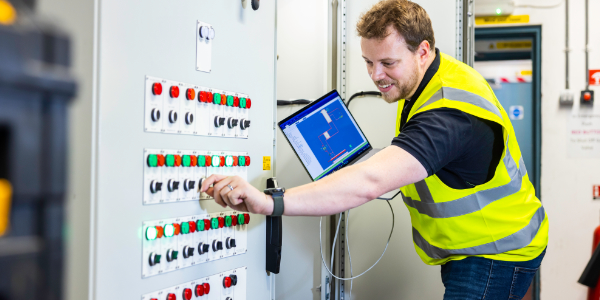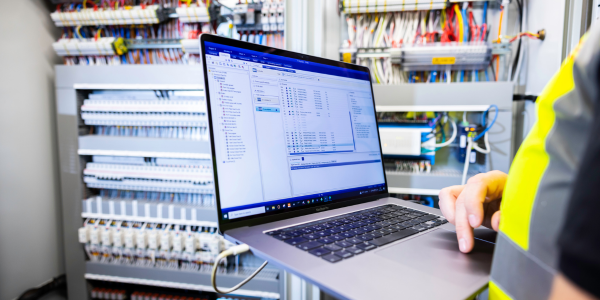As the need for sustainable energy consumption escalates, Building Energy Management Systems (BEMS) are emerging as critical tools for optimising energy use in buildings. With the UK’s commitment to achieving net-zero emissions by 2050, the focus on innovative energy management solutions is more pertinent than ever. This blog explores the top five BEMS trends and innovations as we approach 2025 and beyond. From improved data analytics and smart energy storage solutions, to the integration of renewable energy sources and Virtual Power Plants (VPPs), these building energy management system trends are not just enhancing operational efficiency, they are also paving the way for a greener, more sustainable future in the built environment.
What is a Building Energy Management System?
BEMS began to emerge in the 1970s and 1980s in the UK as a response to the demand for better energy consumption control in larger buildings. Early designs were rudimentary, automating Heating, Ventilation and Air Conditioning (HVAC) systems only. Now BEMS are fully integrated with the Internet of Things (IoT) and supported by Artificial Intelligence (AI),building managers and owners are able to monitor, analyse and optimise multiple energy consuming systems at the same time.
How does a BEMS differ from a Building Automation System?
There are key differences between a BEMS and a Building Automation System (BAS). The primary focus of a BEMS is to optimise energy consumption, by analysing, monitoring and optimising systems that typically consume a lot of energy, such as lighting, water management and energy generation or storage. The end goal is to reduce energy waste, improve sustainability where possible and lower operating costs.
In contrast, a Building Automation System automates and controls a broader range of building management functions, including security and access control, fire safety, elevators and more, in addition to the energy consuming functions, creating some overlap with a BEMS. However, the key difference with a BEMS is the focus on reducing energy use and the depth of energy management, by collecting detailed energy data, performing advanced analytics, and using this information to optimise systems for the most efficient energy use.
Read our Guide to Building Automation Control Systems to understand the key differences between Smart Buildings, Building Automation Systems and Building Management Systems.
BEMS Trend 1:Improved Data Analytics
In 2025 and beyond, improved data analytics is transforming BEMS with the integration of IoT and AI. IoT devices allow for real-time data collection from various functions within the building – whether it’s HVAC, lighting or water management – delivering up-to-the-second insights into building performance. When coupled with AI, these systems can process vast amounts of data, identifying patterns, predicting energy demand and suggesting optimisations that can go beyond human capabilities. Additionally, the adoption of cloud-based platforms enables building managers and facilities managers to remotely monitor and control building systems from any location, enhancing flexibility and responsiveness. This cloud capability also facilitates easy sharing of critical data with stakeholders, improving collaboration and decision-making without delay.
This trend not only improves day-to-day energy management, but also provides a strategic edge for long-term sustainability goals.
BEMS Trend 2: Occupants’ growing expectations for lower energy consumption
As sustainability becomes a priority, building occupants are increasingly demanding lower energy consumption from the spaces they use. In response, AI-driven BEMS analyse data on occupancy, weather and building usage patterns to ensure that energy is only used where and when it’s needed, reducing waste and lowering costs.
As national demand response initiatives, such as the Interoperable Demand Side Response (DSR) Programme, become more common, BEMS can adjust energy consumption in response to signals from the National Grid. During peak energy periods, buildings can reduce non-essential energy use or shift to stored energy, helping to stabilise the grid while cutting expenses. These innovations not only meet occupants’ expectations for more energy-efficient environments, but also align with national efforts to reduce carbon emissions and energy demand.
BEMS Trend 3: Integration with Renewable Energy Sources and Microgrids
As the push for sustainability intensifies, the integration of renewable energy sources and microgrids into BEMS is emerging as a key trend. By harnessing solar panels, wind turbines and other renewable technologies, buildings can generate their own energy, significantly reducing reliance on traditional power grids. BEMS can optimise this energy use, ensuring that buildings consume self-generated energy first, minimising waste and lowering energy costs.
Microgrids, local energy systems that operate independently or in conjunction with the national grid, and use and store renewable energy sources, enable buildings to operate independently and without interruption to facilities during grid failures. This integration also allows BEMS to have more control over energy flow, improving overall efficiency and supporting demand response initiatives. Using advanced analytics and real-time data, BEMS can dynamically adjust energy consumption based on available renewable sources, ensuring that buildings not only contribute to carbon reduction efforts but also benefit from enhanced energy security and cost savings.
BEMS Trend 4: Smart Energy Storage Solutions
The rise of smart energy storage solutions, such as batteries, allows BEMS to store excess energy generated from renewable sources like solar panels, ready for use during peak demand periods or grid failures. By integrating smart storage with BEMS, facilities can optimise their energy usage, reducing costs and reliance on the grid. These systems use intelligent algorithms to predict energy demand and adjust charging and discharging cycles accordingly, maximising savings and ensuring energy availability when needed.
BEMS Trend 5: Investment in Virtual Power Plants
Investment in Virtual Power Plants (VPPs) is surfacing as a new trend within BEMS. VPPs are networks that aggregate distributed energy resources to optimise energy production and consumption, enhancing grid flexibility. This allows buildings to participate in energy markets and respond to real-time grid demands by adjusting their energy output or consumption.
Additionally, they enable buildings to capitalise on financial opportunities by selling excess energy back to the grid or participating in demand response initiatives. As technology advances, the integration of VPPs with BEMS will empower buildings to play a more active role in the energy landscape, contributing to a more sustainable and efficient energy future.
BEMS are crucial for fostering a sustainable future
The building energy management trends highlighted here are transforming the way our community collectively manages energy. The technological innovations mentioned enhance operational efficiency, but also empower Building Managers and Facilities Managers to significantly reduce their carbon footprints. Key trends, such as greater demand for more sustainable energy consumption from building occupants are driving the adoption of advanced systems that optimise energy usage and minimise waste.
Additionally, the integration of renewable energy sources, smart storage solutions, and Virtual Power Plants (VPPs) enables buildings to operate more independently and sustainably. As we embrace these innovations, we not only align with global sustainability goals but also create healthier, more efficient environments for current and future generations.
Cube Controls is an established and experienced supplier of Building Management Systems, specialising in the design and set up of bespoke environmental and energy control programmes for commercial buildings and property.
To find out how Cube Controls can support you at all stages of design and consultancy, installation and modification and maintenance of your building management systems contact our expert and friendly team on 01903 694279 or sales@cubecontrols.co.uk.




